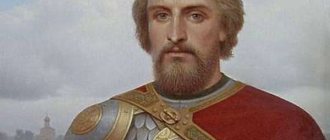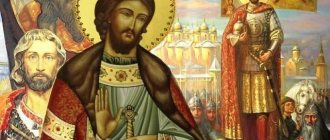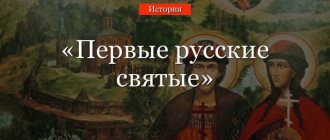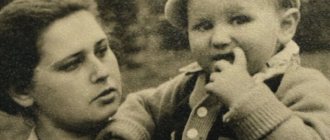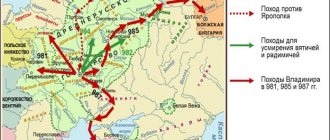Alexander Nevsky, whose brief biography is presented in this article, was not only a Grand Duke, but also a famous commander, whose merits are still revered. Indeed, thanks to his victories in such battles as the Battle of the Neva and the Battle of the Ice, our country not only remained independent, but also asserted itself among other states.
For his exploits before the Fatherland and his strong Orthodox faith, Alexander Nevsky was glorified among the saints as the Holy Blessed Prince.
Brief biography of Alexander Yaroslavich
Alexander Nevsky was born on May 13, 1221 in the family of Prince Yaroslav Vsevolodovich of Vladimir and Princess Rostislava Mstislavovna. He was the second of nine children. Until the age of nine, the prince lived in Pereyaslavl-Zalessky, and then, together with his older brother Fedor, he left to rule in Veliky Novgorod.
After 3 years, the elder brother died, and after another 3 years, the prince’s father moved to rule in Kyiv. Therefore, by the age of 16, Alexander Nevsky became the independent ruler of Novgorod, one of the richest and most influential cities of the 13th century.
Myth four. Alexander was a fierce opponent of Catholicism
The Horde invasion presented the Russian princes with a difficult choice - either to fully recognize their dependence on the nomads, or to seek help in the West. Alexander's contemporary Daniil Galitsky took the second path, accepting the royal crown from the Pope. With this step of the prince, a religious split began in the Russian lands, and the Principality of Galicia would gradually lose its independence, becoming a “transitional” region in disputes between large countries. The Lithuanian prince Mindovg converted to Catholicism to get rid of attacks from the Teutons.
Alexander also considered a similar possibility. Moreover, there is information that the prince even gave some preliminary promises to Pope Innocent IV But ultimately he abandoned these intentions. That did not prevent Catholics from calmly trading with Pskov and Novgorod and feeling confident in Russian cities.
Henryk Semiradsky. "Prince Alexander Nevsky receives the papal legates." 1876 Photo: reproduction
Historical portrait of Alexander Nevsky
Alexander Yaroslavich ruled from 1236 to 1263 in the Novgorod, Kiev and Vladimir principalities.
He began his story as a warrior. While still very young, he fought on Izhora, which flows into the Neva, with German knights. A little later, he fought for Pskov with the Teutonic knights and took part in the Battle of the Ice.
During the reign of Alexander Yaroslavich, the Old Russian state suffered a difficult fate; it had to pay tribute to the Golden Horde and defend the state from Western invaders. At that time, every prince who wanted to receive the title of great had to go to the Horde for a golden label. Alexander Nevsky was no exception.
After the death of his father, he went to Mongolia to ask for the Principality of Vladimir. In total, Alexander Yaroslavich visited the Horde 2 times. The second time he went there because of the unsuccessful campaign of his brothers against the Horde, in order to save Russian cities from the wrath of the Tatar-Mongols. He was able to convince the khan not to attack Rus', but died on the way home.
How does the work end?
As befits a hagiography, according to plan, the final part invariably describes the death of the main character. The next (fourth) trip to the Horde in 1262, the result of which was the agreement of Khan Mongke not to take any of the Russian people to conquer new territories, led to a long illness of the prince.
In 1268 and died in the city of Gorodets. The author of the life describes a “wonderful and worthy of memory” miracle: during the burial, Metropolitan Kirill III, following tradition, was supposed to place a “farewell letter” into the sovereign’s hand. But during the ceremony, the hand of the deceased himself reached out and took the letter from the hand of the amazed metropolitan.
The childhood of Alexander Nevsky
Almost nothing is known about the childhood and youth of Alexander Yaroslavich. When Alexander was 5 years old, his father initiated him and his brother Fyodor into warriors. After 3 years, the brothers were sent to reign in Veliky Novgorod.
Life in Novgorod with its free and militant disposition played a big role in his worldview. Alexander knew from childhood that someday he would become a warrior and lead an army, like his father once did.
In 1237, disaster befell Rus' - Russian cities were burned and robbed by Batu’s soldiers. At that time, many princes were killed and the survivors were taken prisoner. In order to protect his lands and save the lives of his children, Yaroslav Vsevolodovich agreed with Batu to pay tribute.
However, the worst thing awaited the Russian state ahead. Having learned about the plight of the Russian princes, the Pope decided to forcibly baptize the Russian people into the Catholic faith, and give the conquered territories to the families of the knights of the Order.
Just at this time, 17-year-old Alexander Nevsky was able to establish himself as a wise ruler and a good commander, setting up several defensive points on the Sheloni River and entering into an unequal battle with the crusaders.
Who is the story talking about?
A literary work written in the Nativity Monastery (Vladimir) tells us about the commander Alexander Nevsky. Born in Pereyaslavl in 1219. Father Yaroslav was a believer and a fair father, mother Theodosius is described as a quiet and submissive woman. From an early age, the future ruler showed interest in science and grew up dexterous and strong. Already at the age of 17 he took the main post in Novgorod, and at the age of 20 he gained wide fame among the population.
Metropolitan Kirill (namely, many scholars point to him as the author of the story) points out that the commander and strategist, before any important actions - campaigns or wars - invariably indulged in prayers. This further emphasizes the connection between the spiritual sphere and the Russian land: it is not for nothing that in the everyday life of that time the words were heard every now and then: “We are Russians, God is with us.”
Grand Duke's parents
The father of Alexander Nevsky was Yaroslav Vsevolodovich, who reigned in Vladimir. His grandfather was Vsevolod the Big Nest, and his great-grandfather Yuri Dolgoruky, who also went down in history as great figures of Rus'.
Alexander Nevsky's father, Prince Yaroslav Vsevolodovich
Nothing more is known about the boy’s mother, except that she was of a princely family. Some sources say that she was the daughter of Mstislav the Udal (Lucky) - one of the famous warriors and princes of that time.
Significance for history
Until the end of the 16th century, Alexander Nevsky was a role model for a whole list of statesmen of all ranks. One of the monasteries in St. Petersburg bears his name, and the order of the same name was awarded to dozens of commanders who showed courage and courage during the Great Patriotic War.
“Noble protector of people,” “spiritual leader,” “wise protector”—dozens of positive epithets characterize the prince from various angles.
His loyalty to ideals, desire to protect the state and spiritual kindness are forever enshrined in “The Life of Alexander Nevsky” - one of the monuments of ancient Russian literature. Share on social media networks
Children of Alexander Nevsky
The exact dates of birth of the sons of Alexander Nevsky are unknown. The eldest son Vasily was presumably born before 1245. He inherited the Novgorod inheritance.
The next son of Prince Dmitry was born in 1250. He was the ruler of Novgorod, Pereslavl and Vladimir. Andrey (1255) was the ruler of the Kostroma, Vladimir and Novgorod principalities after the death of his older brothers.
The most famous of his children was his youngest son, Daniel, who was nicknamed the first collector of lands around Moscow and the first Moscow prince.
Nevsky's daughter Evdokia married Prince Konstantin Rostislavich, who ruled in Smolensk.
What about diplomacy?
After the death of Nevsky’s father, who became the dominant man in several principalities, Batu Khan called to bow. Gathering a small squad, the young sovereign set off. I didn’t intend to fight, I had to come to an agreement. After a long conversation with the khan, all honors were given to him as the governor of the Horde on the Russian lands, and assurances were also given of peace, which was guaranteed to the lands of Rus'.
The story also describes with quotes another case of nobility: Alexander’s brother, Andrei, who ruled in Suzdal, was severely punished by Batu for his self-will. The Mongol army devastated the lands of the Suzdal principality, opening it to destruction by a number of neighboring enemies. But Alexander came to the rescue - not only restoring the capital, but also, by his own will, again establishing his brother on the throne.
Who did Alexander Nevsky fight with?
During his short but glorious life, Alexander Nevsky was able to achieve many important victories for the state. To do this, he had to fight several foreign invaders almost simultaneously.
His enemies were the Swedes from the Livonian Order, who appeared at the walls of Veliky Novgorod in 1240. Also, Alexander Nevsky fought with German knights in 1242 and with Lithuanian troops in 1245.
Battle of the Neva (1240) for the prince
In July 1240, Swedish Vikings approached the confluence of the Izhora and Neva rivers in their boats and set up camp. They arrived to attack Novgorod and Ladoga. According to the chronicles, about 5 thousand Swedish invaders arrived, but Alexander managed to gather only 1.5 thousand warriors. There was no longer any time to delay. While the Swedes are in the dark and are just preparing for an attack, it was necessary to get ahead of them by unexpectedly attacking their place of deployment.
Alexander and his small retinue settled in the forest not far from the Swedes. Even the Swedes had no sentries, and the Vikings themselves were busy setting up the camp. Alexander, after carefully studying the location of the enemies, decided to divide the army into three parts: the first was to move along the coast, the second - the cavalry, led by Alexander himself, should advance in the center of the camp, and the third - the archers, remained in ambush to block the path of the retreating Swedes.
The morning attack of the Novgorodians was a complete surprise for the Swedes. Novgorod resident Mishka managed to approach the tent where the command was seated unnoticed and sawed off the leg. The tent fell along with the generals, which caused even greater panic among the Swedes. When the Varangians rushed to their augers, they saw that they were already occupied by the Novgorodians. The path was completely cut off when the archers entered the battle.
The Novgorod Chronicle speaks of huge losses in the Swedish camp and only 20 people were killed in the Russian regiment. From that time on, Alexander began to be called Nevsky in honor of the river where he won his first significant victory. His fame and influence in Novgorod increased, which was not very to the taste of the local boyars, and young Alexander soon left Novgorod and returned to his father in Vladimir. But he doesn’t stay there for long either, and moves to Pereslavl. However, already in the next 1241, Alexander received news from the Novgorodians that the enemies had again approached their native lands. The Novgorodians called on Alexander.
Briefly about the exploits of the great commander
Today he is placed on a par with the most outstanding commanders in the entire history of Russia. And this is no coincidence. He has several victories that are significant for the entire Russian world.
His first victory was won on June 15, 1240 on the Izhora River against the Swedish conquerors. In the summer of that year, knights of the Levon and Teutonic Orders appeared under the walls of Novgorod, who came to Rus' to convert people to the Catholic faith.
The Swedish part of the united order did not wait for the Germans and set out. Alexander Nevsky, without waiting for his father’s help, opposed the invaders and defeated them.
The second feat of Alexander Yaroslavich is known in history as the Battle of the Ice. It happened on April 5, 1242 on Lake Peipsi, which by that time was already in the inhabited territory of the German crusading knights.
Nevsky's last victory dates back to 1245. The battle against the Lithuanian invaders lasted for several days and ended in victory for Nevsky’s squad.
The Battle of the Ice and the victory of Alexander Nevsky
The Battle of the Ice or the battle against the Teutonic Order took place on April 5, 1242 on Lake Peipsi. Thanks to the resourcefulness and cunning tactics of the young prince, the troops of the order were surrounded on the flanks and defeated.
The remnants of the Teutons were overtaken by the princely squad for a long time on the frozen lake. As a result of this battle, about 500 knights drowned in the lake, and another 50 were captured.
In recent years, there has been increasing debate about why so many knights drowned. According to one version, the knights were dressed in heavy armor, due to which the ice on Lake Peipus could not stand it and cracked. However, according to other reports, this information appeared recently and has nothing to do with the actual events taking place.
One way or another, this battle was of great importance for the state. After him, an agreement was concluded that put an end to the Crusaders' raids.
The image of Alexander Nevsky in art
There is no authentic image of the prince left to this day. His image was reconstructed based on descriptions from various sources, which was reflected in Russian literature, art, and cinema. A verbal portrait of the prince can be found in his life, the content of which tells about his many exploits.
One of the most popular portraits of Alexander Nevsky was painted from the actor from the film of the same name directed by Sergei Eisenstein. The prototype for the Order of the Grand Duke was also taken from him.
In addition, many streets and temples are named after the prince, not only in our country, but also abroad. In many cities of Russia you can find monuments dedicated to him.
How is the sovereign described?
In moments of peace and quiet, Nevsky is a quiet and humble person, full of spiritual meekness. This is evidenced by the ruler’s constant appeals to prayers, to the patrons of his family in heaven. In turbulent moments of battle, the prince is courageous, ardent and merciless.
It describes unprecedented dedication in battle, which leads a huge human army, swiftness of action, invariably leading to victorious maneuvers, and after the battle - generosity towards those killed in battle, towards captured enemy people, towards the wounded and maimed. This ideal of a ruler: on the one hand, wise towards his subjects, and on the other, merciless towards his enemies, remained for a long time in ancient Russian history as one of the main archetypes of narratives.
The connection with the saints is constantly emphasized in the story and life, and the courage that is inherent in the prince is invariably determined by the signs that heaven gives. In particular, the story tells an incident when, during a battle, one of the elders, close to the commander’s headquarters, had a vision of the martyrs Boris and Gleb.
It is described as follows: an elder named Pelguy, during his next patrol, saw Boris and Gleb sailing across the sea in a boat “in scarlet robes” (crimson, dark red) “holding their hands on each other’s shoulders,” looking at the land. After this, Pelguy heard that one of the brothers, Boris, said: “Tell us to row, and let us help our relative, Prince Alexander.”
It is no coincidence that such lines are indicated in the essay: “relative” is a blood relative, a close soul. Nevsky is helped due to his relationship with the angels, with the forces from above. Therefore, even a small Russian army was able to defeat the Swedes in the battle, and the commander himself “wounded the king himself in the face,” which meant an unconditional victory. In addition, the narrator, describing the portrait of Alexander, compares it with images from the Bible: he has the strength of Samson, the beauty of Joseph, the wisdom of Solomon, and the courage of Vespasian.
Interesting facts about Alexander Nevsky
There are dozens of interesting facts about the activities of this famous person. The most interesting and relevant of them are in this selection.
Why was the prince named Alexander Nevsky?
Alexander received his nickname, Nevsky, for his brilliant victory over the German knights on the Neva. This not only glorified him, but also for a long time discouraged Western states from attacking Rus'.
How tall was Alexander Nevsky?
It is noteworthy that Alexander Nevsky was small, even small by modern standards, in height - no more than 156 cm. Scientists made such conclusions on the basis of the white stone tomb, which supposedly belongs to Nevsky.
When is the day of memory of Alexander Nevsky celebrated by the Orthodox Church?
Orthodox Christians recognize two memorable dates for the Blessed Prince - September 12 and December 6. The first date marks the transfer of holy relics from the Vladimir land to St. Petersburg. The second date denotes the solemn funeral of the prince, which, according to the old style, took place on November 23, 1263.
When did the prince go to war for the first time?
Nevsky began to fight long after he himself stood at the head of the army. His first fight took place when he was 13 years old. Then his father took him to the battle against the Lithuanians in Dorpat. It was then that the young prince realized who his enemies really were.
